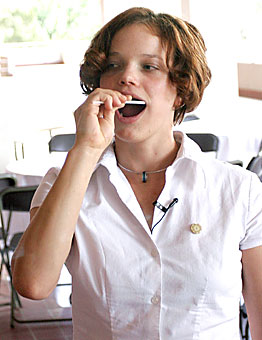 |
|
JOSH FIELDS/Arizona Daily Wildcat
|
Biology senior Barbara Fransway swabs her cheeks for DNA at the BioSciences West building yesterday. Researchers were on campus to present the National Geographic Genographic Project.
|
|
|
By Djamila Noelle Grossman
Arizona Daily Wildcat
Thursday, April 14, 2005
Print this
The UA's participation in a population genetics undertaking was announced yesterday, giving people around the world an opportunity to trace their ancestry to the dawn of mankind.
The Genographic Project is a collaboration of National Geographic and IBM, which have contracted UA scientists at Arizona Research Laboratories to screen hundreds of thousands of public DNA samples, said Matt Kaplan, the project coordinator.
The overall goal is to create a map of human migration on Earth, Kaplan said.
UA researchers only work on the part of the project where people request and pay for their DNA to be studied. Other international research labs screen genomes of 100,000 indigenous people worldwide who volunteer their DNA for the project, said Kaplan, an ecology and evolutionary sciences doctoral candidate.
"I'm very excited to be part of creating an outstanding dataset and online museum," Kaplan said, "because this is a possibility for the world to realize how closely related all humans are."
Michael Hammer, a UA scientist who studies ecology, evolutionary biology and anthropology, will supervise the project, and he said he is excited about it because it gives the university and his team world recognition.
"I think it's a feather in the cap of the university," Hammer said.
The UA has analyzed 35,000 gene samples in cooperation with Family Tree DNA over the last years, Kaplan said, which made the UA a major candidate for the project.
In the anonymous screening, the Y chromosome in men and mitochondrial DNA of the genome in women are screened for mutations in certain regions that do not explain the person's health, but rather their family history, Kaplan said.
The response to the project by the general public is very strong, Kaplan said, and he believes there have already been thousands of orders.
"We're hoping that we will not be overwhelmed. We're scaled up to do 10,000 a month," Hammer said. "But you know, if it's 100,000 a month then we're in trouble."
The kit that is available online at National Geographic is sent to the person, who will take a saliva sample and send it to the UA, Kaplan said. Four to six weeks later the results are received.
Proceeds from the sales are donated to a legacy foundation that sponsors aid programs in third world countries, Kaplan said.
Michael Cusanovich, professor of biochemistry and molecular biophysics and director of the Arizona Research Laboratories, said the project, scheduled to take five years, is a validation of the technology used at the university.
The general public also enjoys being in contact with genetic research on a positive basis, Cusanovich said.
"They enjoy science instead of worrying about heart diseases," Cusanovich said. "It's a lot of fun, but it also has a lot of scientific value in the long run."
Tara Luckau, a senior in ecology and evolutionary biology, said she has worked at the lab for the last two years, assisting in analyzing genetic data.
At some point, Luckau said she had her own genetic information analyzed and found the results exactly resembled the part of her family history she is aware of.
In the new project, Luckau will be recording the information about the Y chromosomes in men, processed by a machine.
Most of the work in the lab will be done by robots, Luckau said, because the researchers "don't have enough hands" to handle the demand.
